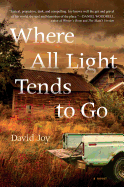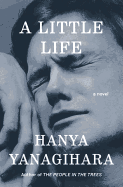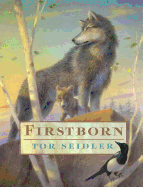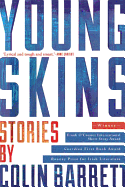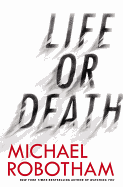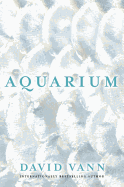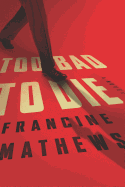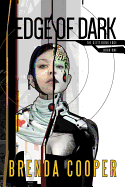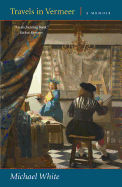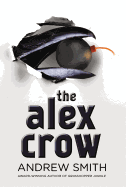Friday, March 13, 2015
If you're like me, you've picked up your computer skills from being shown something--usually too quickly--and supplemented that with the so-called "help" feature and some Google searches. You learn a task one way, then perhaps discover there is another way; one of life's great mysteries is that the other way is always shorter and easier. But usually you are just mired in habit (and frustration).
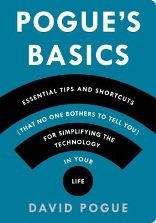
Pogue offers camera tips, too: direct sunlight makes for terrible portraits, and how to make a tripod using a table lamp or an eyehook and string. Smart phones: how to find your lost phone, save a map to use offline, bring a wet phone back from the dead, and what Siri is actually good for. E-mail: use temporary e-mail addresses for verification, so spammers don't get your actual info; fake e-mail stories--verify with snopes.com. Google: as in Pogue's other chapters, much information will be obvious to many users, but not all--I just learned that if I want to search for dolphins (the creatures, not the team), I type dolphins -Miami, and the minus sign eliminates the city.
225 tips to make life easier, from gadget basics to social networks: tweet that! --Marilyn Dahl, editor, Shelf Awareness for Readers
Where All Light Tends to Go
by David Joy
First-time novelist David Joy (author of the fly-fishing memoir Growing Gills) lives in the Blue Ridge Mountains of southwestern North Carolina--the same isolated setting where Jacob McNeely, the 18-year-old narrator of Where All Light Tends to Go, struggles with the dead-end life fate seems to have handed him. Joy's grim but satisfying story of the McNeely family faithfully echoes the language and atmosphere of this largely lawless mountain culture, a place where few "ventured without a good four-wheel-drive and a chainsaw," where people's broke-down shacks sit among broke-down trucks and cars such that "the whole lot was in dire need of a tetanus shot."
Choking in the tight hold of a ruthless drug-dealing father and largely ignored by a drug-addicted mother, Jacob quits school to take up his father's trade in a place with few options. As he sees it: "Blood's thicker than water, and I was drowning in it." He finds hope in Maggie Jennings, a top student and his much-coveted lover, who is not like the "girls who'd been raised on mayonnaise sandwiches in the holler." Like the FX series Justified or AMC's Breaking Bad, Joy's novel may be driven by hillbilly characters and a dope-dealing plot, but its heart is in its circumscribed setting. Maggie can get away to college, but Jacob sees the only other way out in death--"a place where all light tends to go, and I reckon that was heaven." Grim perhaps, but a story skillfully written. --Bruce Jacobs, founding partner, Watermark Books & Cafe, Wichita, Kan.
Discover: A first novel told by a young man trying to escape a violent father and a hardscrabble Appalachian county.
A Little Life
by Hanya Yanagihara
A promising law clerk and a fine aspiring actor lease a meager apartment in Manhattan. The friendship forged there between Jude St. Francis and Willem Ragnarsson lays the foundation for their many years together in A Little Life, the astonishing second novel by Hanya Yanagihara (The People in the Trees). Interwoven with these two are their close friends, frenetic artist JB and stalwart architect Malcolm. The foursome's dynamic relationships comprise a lush backdrop for the greater drama gradually unfolding in the decades of Jude's adulthood.
In a story with many moving pieces, Yanagihara fleshes out each character with an empathy that fully embraces their desires and revulsions, so that every break of trust, every tender moment, every secret revealed reverberates across the novel's dazzling panorama. Still, she never loses sight of its enigmatic hub: Jude St. Francis, a man of indeterminate race, with no relatives to speak of, a suspect lack of sexual expression, an excruciating disability he insists not be mentioned, and an entirely inscrutable childhood.
To his friends, Jude is conspicuous in his desire to go unnoticed in the modern era of identity politics, but how long can they maintain the charade of overlooking his vacillating health and psychological distress before Jude becomes a danger to himself? The power of Yanagihara's prose levitates even the heaviest of sorrows. She is a master observer of the human psyche, in all of its fits and starts, and A Little Life vibrates with the hope of personal redemption, delivering something far greater than its humble title presumes. --Dave Wheeler, associate editor, Shelf Awareness
Discover: Hanya Yanagihara's potent second novel unearths secrets one man has kept meticulously since childhood as he gradually comes to trust a few special friends.
Young Skins: Stories
by Colin Barrett
Set in and around the small town of Glanbeigh, Ireland, Colin Barrett's debut collection of short stories plunks readers deep in the nightlife and gritty underbelly of Glanbeigh's seedier side. His male characters are tough, hard-drinking thugs, drug dealers and general losers. The women these men ogle are just as hard, often saddled with kids born out of wedlock, who titillate the men out of boredom or in the hopes of a free drink. Barrett uses expressive details to instill a raw energy into his characters and sum them up in very few words, like his description of Nubbin Tansey, a "town tough and marginal felon" who enters a bar wearing a T-shirt, "exposing veined biceps as tough and gnarled as raw root vegetables." His two bodyguards are "twin slabbed stacks of the densest meat, their breezeblock brows unworried by any worm of cerebration."
Although the spiraling cesspools that constitute their day-to-day existence threaten to suck them in deeper and deeper, the characters are striving to do something decent and genuine with their lives. In "Calm with Horses," a young father named Arm makes a point of interacting with his handicapped son, even though Arm has just beaten up a child molester and is headed to conduct a drug deal. The boy in "The Clancy Kid" declares his love for a girl who has already denounced him. Despite their toughness, rough edges and use of foul language, Barrett's characters are likable, and they show a side of Ireland many may not be familiar with. --Lee E. Cart, freelance writer and book reviewer
Discover: Stark and uncompromising stories of local Irish life.
Life or Death
by Michael Robotham
Michael Robotham takes a break from his series character Joseph O'Loughlin for the standalone Life or Death, about a man named Audie Palmer who escapes from prison one day before he's scheduled to be released. Why would he turn himself into a fugitive when he could've been a free man the following day?
Perhaps the answer lies in his past. In 2004, robbers hijacked an armored truck. Sheriff's deputies chased and killed two perpetrators when the truck crashed. Audie survived a shot to the head at the scene, pled guilty to being the driver and received a 10-year sentence. The $7-million haul, however, was never recovered.
After he breaks out of prison, Audie is spotted outside the house of the former deputy--now sheriff--who shot him. This sets off a manhunt by local and federal law enforcement officers, including Sheriff Valdez and FBI Special Agent Desiree Furness. When more deaths occur, all blamed on Audie, Furness begins to question "official" versions of events, going back to the armored truck hijacking.
Audie is a captivating character, enigmatically enduring hell in prison with a Zen-like attitude. What keeps him going is an old promise he made, and readers will be eager to discover what that promise is. Well-developed supporting characters are painted in shades of gray, their motivations not all bad or good but plausible. Robotham, an Australian, convincingly evokes the feel and rhythms of Texas and its people, while telling a story that's as beautiful as a wide-open sky and as full of heartache as a country love song. --Elyse Dinh-McCrillis, blogger at Pop Culture Nerd
Discover: A man escapes from prison one day before his release in order to keep an old promise.
Aquarium
by David Vann
Aquarium starts unassumingly enough, suspended in the blue hush of a Seattle aquarium. David Vann (Dirt; Caribou Island) introduces the reader to 12-year-old Caitlin, the voice of this high-velocity narrative. In a novel rife with violent exchanges of power, it's one of few moments when life might be described as peaceful. Hold on to that feeling, it won't last long.
The novel hinges on an encounter between Caitlin and an elderly man at the aquarium, the implications of which threaten to shatter her precarious sense of family. Vann's greatest triumph is his illustration of the personae orbiting Caitlin like so many moons--her mother, Sheri, a volatile shipyard worker who feels robbed of her own adolescence; her mother's affable but ineffectual boyfriend, Steve, who fails to intercede during Sheri's bouts of rage; and Shalini, Caitlin's more-than-best-friend, whose refinement and international upbringing stand in stark contrast to the Seattle of Caitlin's life. Save for the tropical fish in their tanks, which she visits daily, she has known only a city cold and lacking in color. Vann includes helpful photographs of each underwater specimen, like the square-headed, grumpy silver ghost and twig-like, luminescent ghost pipefish.
Occasionally, the language falters--"I wanted all of the sadness to stop and everyone to just come together," says the otherwise eloquent Caitlin--but the dialogue is so sharp it's sometimes painful. Sheri's epithets are simultaneously stringent and sickeningly believable. Steve's kindly ineptitude is heartbreaking, then infuriating. Caitlin begins as a helpless child, but by the novel's close, she navigates her perilous circumstances with the grace of a fish in midstream. --Linnie Greene, freelance writer
Discover: An unflinching novel about adolescent revelations and a family on the brink of implosion.
Mystery & Thriller
Who Buries the Dead
by C.S. Harris
In 1813, Sebastian St. Cyr, Viscount Devlin, is rather enjoying domesticity and his new son. But he's called to help the Bow Street magistrates yet again, when the body of a socially ambitious man is found on a bridge, with his head stuck atop a spike. The victim, Stanley Preston, is best known for three things: his cousin is the Home Secretary, he owns a large plantation in Jamaica and he's an obsessive collector of historical artifacts (and isn't too picky about their provenance)--which perhaps explains the coffin strap, reading "King Charles, 1648," found nearby.
Investigating Preston's life draws Devlin into the scary, hidden world of grave robbers and smugglers, as well as high-society events where government officials, debutantes, lords and plantation owners mingle. Using his own contacts, and those of his father-in-law, who is close to the Prince Regent, Devlin will stop at nothing to find Preston's murderer. Unfortunately for the safety of Devlin and his family, the killer is equally determined to keep his identity hidden.
With excellent historical detail, Harris again brings the Regency era to life in Who Buries the Dead, the 10th thriller starring Devlin. Who Buries the Dead also includes sly, tongue-in-cheek references to Jane Austen's books, since Jane herself is a close friend of Stanley Preston's daughter. Those who enjoy historical mysteries, Jane Austen and Regency fiction will enjoy Who Buries the Dead on its own. And longtime fans of the series will be happy to see intriguing developments in Sebastian's unduly complicated personal life. --Jessica Howard, blogger at Quirky Bookworm
Discover: A thrilling historical mystery set in Regency London.
Too Bad to Die
by Francine Mathews
In this historical thriller, Ian Fleming, tired of being a deskbound intelligence officer, spends his spare time writing stories featuring a British agent known as 007. But in November 1943, Fleming's real life becomes much more exciting than his imaginary one. He accompanies Winston Churchill's retinue to Egypt, where they convene with Franklin Delano Roosevelt, before heading on to Iran to meet with Joseph Stalin.
Fleming intercepts a message implying that a high-ranking Nazi spy known as the Fencer, who has been outwitting the Allies for years, plans to infiltrate the Tehran summit and kill the three world leaders. In his race to stop the assassinations, Fleming will have to overcome the doubts of his superiors, the daggers of his enemies and the determination of the Fencer.
Both an intense thriller and the gripping life story of a complicated man, Too Bad to Die will keep its readers on the edge of their seats. Mathews has done an excellent job of reimagining history, as she did in her earlier novel Jack 1939, and creating suspenseful yet plausible events. Those familiar with the real Ian Fleming's novels will appreciate the sly nods to the James Bond oeuvre, as when Fleming encounters a Soviet spy who orders his martini "shaken, not stirred." Likewise, Mathews portrays the major historical figures--FDR and Churchill among them--with apt believability. Too Bad to Die is a thrilling and enjoyable read, a mystery not to be missed. --Jessica Howard, blogger at Quirky Bookworm
Discover: In 1943, Ian Fleming must race to defeat a Nazi superspy in order to save the lives of Roosevelt, Churchill and Stalin.
Science Fiction & Fantasy
Edge of Dark
by Brenda Cooper
Charlie Windar is a ranger on Lym, one of the last surviving planets in human galactic civilization. He helps return the planet to a more primitive state, healing it after humankind's long exploitation of its natural resources. Nona Hall is a wealthy young woman born on the Diamond Deep, a planet-sized space station containing most of the current human population. Nona hires Charlie for a tour of Lym after her father dies with a parting request that she "see a sky." Nona's childhood friend Chrystal lives in a quad marriage aboard space station High Sweet Home, working with her three partners to produce a new strain of herd animal for the good of humanity. Until, that is, her entire station is stolen by the Next--a civilization of machine-based beings--and she wakes up one day inside a robot body.
The incursion by these inscrutable and powerful machine entities sets the story in motion, one that follows the physical, mental and spiritual journey of all three people as they learn more about the mysterious Next and their plans to return to human space.
The first in the Glittering Edge series, Edge of Dark takes place in the same universe as Brenda Cooper's two Ruby's Song novels (The Creative Fire and The Diamond Deep); Nona Hall is the great-granddaughter of Ruby Martin, the protagonist of the earlier books. The characters in Edge of Dark are sharply drawn, and the plot is full of action and deep insight into the future of human society as it takes to the stars. --Rob LeFebvre, freelance writer and editor
Discover: An entertaining, thoughtful novel about three people in the far future who confront their own humanity as they face the possible end of their entire way of life.
Biography & Memoir
Travels in Vermeer
by Michael White
Poet Michael White's unusual and riveting memoir, Travels in Vermeer, opens in the midst of a nasty divorce and custody battle. Reeling, he flies to Amsterdam ("all I'd wanted was an ocean behind me"), and heads to the Rijksmuseum to see Rembrandts. But he is attracted instead by The Milkmaid, a tiny painting by Johannes Vermeer. The maid evokes a "tingling at the back of [his] scalp," and for the next 14 months, White chases the life-changing insights and soothing, healing effect provided by the Dutch master's small-scale, intuitive paintings, in which he sees expressions of love.
White studies biographies and art criticism about Vermeer, while visiting museums in The Hague, Washington, D.C., New York City and London, and sheds light as well on Vermeer's difficult childhood. While the artist occupies the bulk of this brief, eloquent book, a few scenes from White's battle with alcoholism and his tentative success with Alcoholics Anonymous round out a self-portrait sketched with great feeling in few words. Only a poet could communicate so economically, in language deserving of contemplatively paced reading.
White's descriptions competently guide even the most unfamiliar or untrained reader through an appreciation of the mechanics and mysticism of Vermeer's art. Readers will regret the lack of reproductions of the paintings under consideration; but, as he observes upon meeting Girl with a Pearl Earring, "reproductions are useless."
Travels in Vermeer is a thoroughly user-friendly piece of art education, but it is even better as a thoughtful, spare memoir of pain and recovery, unusually formatted and exquisitely moving. --Julia Jenkins, librarian and blogger at pagesofjulia
Discover: A poet's quiet, beautifully composed, powerful story of self-healing by viewing the paintings of Vermeer.
Nature & Environment
Cowed: The Hidden Impact of 93 Million Cows on America's Health, Economy, Politics, Culture and Environment
by Denis Hayes and Gail Boyer Hayes
Much of Cowed: The Hidden Impact of 93 Million Cows on America's Health, Economy, Politics, Culture and Environment is deeply disturbing. In addition to the ways in which beef taxes the environment and the health of consumers, the authors detail the inhumane treatment of these sentient creatures.
However, Denis Hayes (environmental attorney, professor of engineering at Stanford) and Gail Boyer Hayes (writer, environmental attorney) believe the current situation can be remedied. They were inspired to write Cowed after Gail discovered the impact cows have on almost every major environmental problem: "conventional grain-finished feedlot beef produces five times more global warming per calorie, requires 11 times more water and uses 28 times as much land" as other meat sources. The couple's mission became finding solutions to the myriad problems caused by CAFOs (Concentrated Animal Feeding Operations).
Fortunately, the Hayeses found conscientious ranchers, dairy farmers and artisanal cheese makers who treat their animals humanely, live sustainably and make a living. Unfortunately, they are the exception, and a major paradigm shift may be required to encourage consumers to seek organic dairy products and grass-fed and -finished beef in order to dismantle the stranglehold CAFOs have on the industry. The most promising examples come from the E.U. and Australia. However, a few glimmers of hope do appear in the U.S.: Central Vermont Public Service Corporation has a program to turn cow manure into electricity; Avon, N.Y.'s Worm Power--vermicomposting--turns cow manure into valuable soil. Ultimately, Cowed is both fascinating and a call to action. --Kristen Galles from Book Club Classics
Discover: A fascinating journey through the complicated beef industry that will make meat-eaters reconsider what they put in their grocery carts.
Children's & Young Adult
Firstborn
by Tor Seidler, illus. by Chris Sheban
Tor Seidler (The Wainscott Weasel) applies his considerable talents to an interspecies friendship in Yellowstone National Park, where wolves have just been re-introduced.
Narrator Maggie is a magpie born with curiosity who pines to see what's outside of her nest at the Triple Bar T ranch in Montana. Maggie soon sets out to see the wider world, throwing in her lot with a wolf recently captured in Canada and released in nearby Yellowstone. The wolf saves Maggie from a fox, and she decides to guide him back to his family. Blue Boy--named for his blue-black coat--and Maggie become hunting companions; Maggie spies the prey and Blue Boy brings it down. Adventure soon follows. A human shoots a bullet that hits Blue Boy's tracking collar, releasing it, but the bullet lodges in his neck. Three wolves answer Blue Boy's plaintive howl; instead of killing him, they help him heal. The four--plus Maggie--form a pack. Seidler grants his magpie narrator the power of speech and the ability to understand all species. Still, Maggie remains true to her nature--except for the abandonment of her mate. Her aberration sets the stage for Blue Boy's son, Lamar, the firstborn in his litter, to manifest errant behavior such as empathy and a curiosity that sometimes distracts him from the hunt.
Seidler lays out the tradeoffs of interrupting nature's flow without ever taking sides. Maggie's unusual perspective allows readers' affections for the wolves to grow along with hers, as she earns her revered place in the pack. --Jennifer M. Brown, children's editor, Shelf Awareness
Discover: Tor Seidler deftly explores an interspecies relationship, set against the dazzling backdrop of Yellowstone National Park.
The Alex Crow
by Andrew Smith
The author of Grasshopper Jungle and 100 Sideways Miles delivers yet another cutting-edge novel.
Fourteen-year-old Ariel hid from rebel soldiers inside a walk-in fridge and emerged the sole survivor in a small town in an unnamed country poisoned by gas. A year later, Ariel lives in West Virginia with his adoptive American parents and brother. The father, an inventor, works for the Merrie-Seymour Research Group, which focuses on "savings things from nonexistence." One of its products is the family pet, Alex, a bionic crow reincarnated from its centuries-old extinction who is "overwhelmingly disappointed by his existence." (Depression is a side effect for revived animals.) While outlandish, Smith makes this speculative element feel grounded, and sets up future events with a sure hand. The second narrator, Leonard, often referred to as "the melting man," is taking a huge bomb, assembled in a U-Haul, to destroy the Beaver King because Stalin's voice in his head told him to do so. This narrative can be suffocating, appropriately because of Leonard's anxious and suspicious imagination, but it's not nearly as smothering as the third narrative voice, unveiled through the diaries of an Arctic explorer whose ship, the Alex Crow, has been frozen for five months on an 1879 voyage to absolute north.
Readers must reach the end of the story to understand and appreciate fully the magnificence of Smith's interconnected narratives. The author sweeps up readers in a story filled with memorable characters and scenes, laugh-out-loud jokes and plenty of genre-defying strangeness for those who think they've seen it all. --Adam Silvera, children's bookseller
Discover: The author of Grasshopper Jungle interweaves three stories set in a world that includes a 15-year-old refugee's miracle, a resurrection-by-science and a depressed, bionic crow.
Naptime with Theo & Beau
by Jessica Shyba
Anyone who has loved a baby or a dog, and especially those who adore both, will clamor for this equivalent of a family photograph album.
Originally begun as a chronicle of naptime for Beau, her son, and Theo, their puppy, on Jessica Shyba's blog, Momma's Gone City, this captivating book offers enough variety of perspectives and high-quality photographs to keep children and parents returning again and again. It begins with Beau getting droopy ("Beau is sleepy"). His blond hair, the color of a white fleece throw beneath him, and a black long-sleeve T-shirt accentuate the markings of Theo's fur. Next, the pooch's eyes are at half-mast ("Theo is sleepy"), reclining on raspberry and peach sherbet–tinted pillows. "Time to dream" accompanies an image of the two nestled together against gold star–patterned sheets. They sleep on their backs and on their bellies. "Cheek to cheek" is astonishing; the photograph captures the slumbering puppy's cheek atop the sleeping child's cheek.
Anyone who knows toddlers or puppies will be certain these can't have been posed. Who could stay still long enough? And yet.... The lighting looks as if it's streaming through a window--natural yet otherworldly in its perfection.
The strength of the text stems from its construction as a kind of conversation, with a wink, between child and pet. The outtakes on the endpapers will captivate readers as much as the interior images. And the happy outcome is: everyone will want to take a nap! Delectable. --Jennifer M. Brown, children's editor, Shelf Awareness
Discover: A photograph album tailor-made for baby and puppy lovers.


